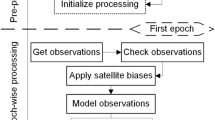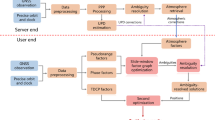Abstract
As location data are widely available to portable devices, trajectory tracking of moving objects has become an essential technology for most location-based services. To maintain such streaming data of location updates from mobile clients, conventional approaches such as time-based regular location updating and distance-based location updating have been used. However, these methods suffer from the large amount of data, redundant location updates, and large trajectory estimation errors due to the varying speed of moving objects. In this paper, we propose a simple but efficient online trajectory data reduction method for portable devices. To solve the problems of redundancy and large estimation errors, the proposed algorithm computes trajectory errors and finds a recent location update that should be sent to the server to satisfy the user requirements. We evaluate the proposed algorithm with real GPS trajectory data consisting of 17 201 trajectories. The intensive simulation results prove that the proposed algorithm always meets the given user requirements and exhibits a data reduction ratio of greater than 87 % when the acceptable trajectory error is greater than or equal to 10 meters.
Similar content being viewed by others
References
Dey A, Hightower J, de Lara E, Davies N. Location-based services. IEEE Pervasive Computing, 2010, 9(1): 11–12.
Lee Y J, Kim M S, Chae J, Yoo W, Lee J W. An intelligent control scheme of moving objects based on smart phones. Database Research, 2012, 28(2): 19–36.
Lee K J, Yang S B. Three effective top-down clustering algorithms for location database systems. Journal of Computing Science and Engineering, 2010, 4(2): 173–187.
Zheng Y, Zhang L, Xie X et al. Mining interesting locations and travel sequences from GPS trajectories. In Proc. Int. Conf. World Wild Web, April 2009, pp. 791–800.
Zheng Y, Li Q, Chen Y, Xie X, Ma W Y. Understanding mobility based on GPS data. In Proc. the 10th Int. Conf. Ubiquitous Computing, September 2008, pp. 312–321.
Zheng Y, Xie X, Ma W Y. GeoLife: A collaborative social networking service among user, location and trajectory. IEEE Data Engineering Bulletin, 2010, 33(2): 32–39.
Potamias M, Patroumpas K, Sellis T. Sampling trajectory streams with spatiotemporal criteria. In Proc. the 18th International Conference on Scientific and Statistical Database Management, July 2006, pp. 275–284.
Meratnia N, de By R A. Spatiotemporal compression techniques for moving point objects. In Proc. Int. Conf. Extending Database Technology, March 2004, pp. 765–782.
Zhou J, Leong H V, Lu Q et al. Optimizing update threshold for distance-based location tracking strategies in moving object environments. In Proc. IEEE Int. Symp. a World of Wireless, Mobile and Multimedia Networks, June 2007.
Lange R, Farrell T, Durr F, Rothermel K. Remote real-time trajectory simplification. In Proc. IEEE Int. Conf. Pervasive Computing and Communications, March 2009.
Lange R, Dürr F, Rothermel K. Online trajectory data reduction using connection-preserving dead reckoning. In Proc. the 5th Int. Conf. Mobile and Ubiquitous Systems: Computing, Networking, and Services, July 2008, Article No.52.
Cao H, Wolfson O, Trajcevski G. Spatio-temporal data reduction with deterministic error bounds. In Proc. Joint Workshop on Foundations of Mobile Computing, September 2003, pp. 33–42.
Orlando S, Orsini R, Raffaetà A, Roncato A, Silvestri C. Trajectory data warehouses: Design and implementation issues. Journal of Computing Science and Engineering, 2007, 1(2): 211–232.
Pitoura E, Samaras G. Locating objects in mobile computing. IEEE Transactions on Knowledge and Data Engineering, 2001, 13(4): 571–592.
Douglas D H, Peucker T K. Algorithms for the reduction of the number of points required to represent a digitized line or its caricature. The Canadian Cartographer, 1973, 10(2): 112–122.
Author information
Authors and Affiliations
Corresponding author
Additional information
This work was supported by the Incheon National University Research Grant of Korea in 2011.
The preliminary version of the paper was published in the Proceedings of EDB2012.
Electronic Supplementary Material
Below is the link to the electronic supplementary material.
Rights and permissions
About this article
Cite this article
Park, H., Lee, YJ., Chae, J. et al. Online Approach for Spatio-Temporal Trajectory Data Reduction for Portable Devices. J. Comput. Sci. Technol. 28, 597–604 (2013). https://doi.org/10.1007/s11390-013-1360-2
Received:
Revised:
Published:
Issue Date:
DOI: https://doi.org/10.1007/s11390-013-1360-2




